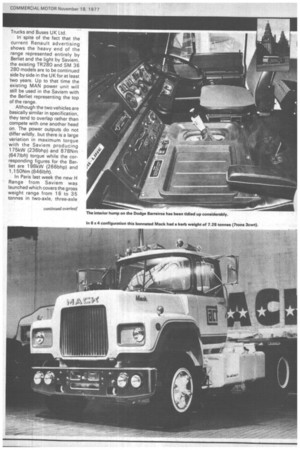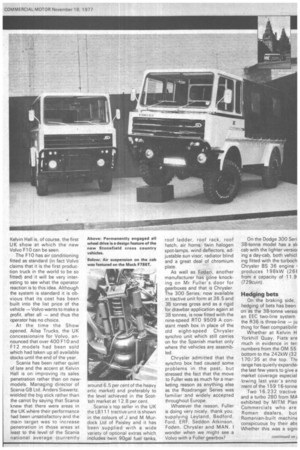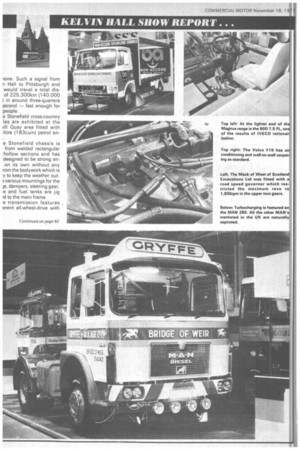1. Heavyweights and mediumweights...
Page 55

Page 56

Page 57

Page 58

Page 59

Page 61

Page 62

If you've noticed an error in this article please click here to report it so we can fix it.
Ready for growth
IS the trade recession over? Most of the manufacturers and dealers at the Scottish Motor Show at Kelvin Hall this week think that the worst is past. But none is brave enough to put any numbers to the predicted growth pattern.
The Show was opened on Friday against a background of conflicting opinions. Conflicting because in the words of Harold Musgrove (general manager of Leylands light and medium division): "There is optimism coming from every quarter." On the other hand, Scottish dealers were bemoaning the trading deals they are having to accept to be able to move new models.
One of the stars of the Show is the new Haulmaster, which along with the European spec Fleetmaster makes up the Foden stand. With the exception of the all-steel 590 cab the Haulmaster owes a great deal to the old S83 model, but the point I find most interesting is that although the long-serving Foden gearbox is standard equipment, a ninespeed Fuller box is now available as an option.
The European 38-tonne Fleetmaster has, of course, got the Fuller box as standard along with the Rockwell axle and has had this since its tentative debut as the "Universal" at Amsterdam in 1974, It will be interesting to see how many operators opt for the Fuller box in the Haulmaster, as I feel it is the thin end of the wedge and soon the Rockwell axle will replace the old Foden wormdrive axle on the Haulmaster as well.
In some ways this would be a great pity as Fodens have always used more in-house components than, say, ERF or Seddon Atkinson.
As far as cabs are concerned Fodens must hold some sort of record in relation to how many different versions are offered — and I don't just mean sleeper or day-cab versions. As well as the Motor Panels cab on the Fleetmaster and Haulmaster range the re-inforced glass fibre S83 cab is still produced for the eight-wheeler, while moving further down the weight scale the lightweight Sixer uses the old 539 cab.
Add to these the half-cabs used on the dumpers and you end up with a fair number of different versions. I wonder how long this procedure will continue as most heavy vehicle manufacturers have enough problems with only one basic cab size.
The S90 cab even in the standard day-cab form is deep indeed measuring an 170cm (67inch) from fro back. As a comparison Scania III in sleeper-cab measures 200cm (78in) ween the same points.
Fodens' backbor
Fodens expect that the ( mins NHC250-eng Haulmaster will form the t bone of the UK sales. And t the specific model on she Glasgow, while the 38-ti Fleetmaster has the L versii the Rolls 290.
Fodens have long I famous for eight-wheelers at the Yorkhill Quay exhibit, a 265L Rolls-Royce engin€ sion whose specification includes tapered leaf sprinc
This is a weight-saving to compensate for the sli heavier weight of the Roll gine when compared w Gardner. But I learn at the that in future all Foden E wheelers will be fitted with I tapered leaf springs as stani
Leyland has chosen K Hall for the first public sho of the Marathon 2, which with the other products fror Truck and Bus Division is I plugging the "Made in Bri aspect.
A possible pointer to future cab design is that the introduction of Marath Leyland has discontinuec full-depth sleeper-cab an placed it with the short sh version previously availab an option.
Although Rolls-enginec sions of the Marathon 2 w phased into the market d early 1978, the TL12 and Cummins version are the ones available at the momi say -only" because Leylan not offer higher power ver of the Cummins (or for matter Rolls-Royce) becau the obvious clash of inte with the Leyland-built TL1:
The Cummins and F engined versions of the on Marathon were introd basically to fill in the gap k the Guy range for operators were committed either by s stocks or workshop exper to Cummins or Rolls eng
as Leyland would offer only lower powered versions of ie particular engines anyway -1 the Marathon tended to h with the Buffalo as far as basic specification went.
;flown in sleeper-cab form, Cummins 290 Seddon Aton 400 for T & M Catto of rdeen is fined with a singleJction Eaton 19128 axle.
the Cummins developing naximum power (204kW or .bhp) at only 1,900 rpm, the 31 Seddon group axle does have a high enough ratio Dn to make the best of the engine speed.
torvvav vehicle
/ith this specification of axle ratio and a Cummins , the 400 should make an I motorway vehicle if our test of the 265 L Rolls ion with an Eaton axle is hing to go by.
le major item of interest on ERF stand is the new non hive suspension fitted to a 3-axle tractive unit which several of the Leyland perel muttering Albion as they 3d at it. ERF admits that the suspension has been around in principle for many years now, but the company's engineers claim that this latest version incorporates a number of advantages aimed at ensuring a long life with the minimum of maintenance.
There is no extra cost in the design, which gives an overall weight-saving of 82kg (1 801b).
The DAF stand looks more a Commercial Motor stand as DAF had proudly emblazoned the details of the record-breaking DAF 2300 road test all over the place. In terms of fuel economy this 172kW (230bhp) tractive unit is in a league of its own at the moment, based on the results of our test.
Although the 2300 has been seen before in the UK, being launched at Earls Court last year, the lightweight 2100 is making its first appearance. The DAF range has a fair amount of interchangeability in component parts and this is well illustrated by comparing the 2300 with the 2100. The frame and cab are the same and basically so is the engine, although it is turbocharged on the 2100 and turbocharged and charged cooled on the 2300 using the same six-cylinder 8.25-litre (503cuin) design.
As fitted to the 2100, the rated power output is 150kW (202bhp), which drives through a six-speed ZF gearbox with a splitter. With a bit of selective
component assembly the DAF engineers have got the weight of the 2100 down to 5.62 tonnes (5 tons 4cwt) which is around 5cwt lighter than the 2300. This has been achieved by fitting a lighter drive-line including the DAF 2255 single-reduction. rear axle.
DAF Trucks (GB) Ltd is certainly optimistic about its prO-. spects for the future based on the fact that it has doubled sales this year compared wi those of 1976.
As far as the French co tenders for the UK market a concerned the news is as mu political as technical. On 't political side Berliet and Savie have finally made it ''officia that, in the future, the joi company will be known as R nault Vehicules Industrie' Although the company has fact been trading under th name for some time unofficial and the new set-up has be anticipated for some time, t.his the first formal accouncement
In this country, Saviem Ltd and Berliet (UK) Citax L will be the end of this year come a single company, Rena Trucks and Buses UK Ltd.
In spite of the fact that the current Renault advertising shows the heavy end of the range represented entirely by Berliet and the light by Saviem, the existing TR280 and SM 36 280 models are to be continued side by side in the UK for at least two years. Up to that time the existing MAN power unit will still be used in the Saviem with the Berliet representing the top of the range.
Although the two vehicles are basically similar in specification, they tend to overlap rather than compete with one another head on. The power outputs do not differ wildly, but there is a large variation in maximum torque with the Saviem producing 175kW (236bhp) and 878Nm (647Ibft) torque while the corresponding figures for the Berliet are 198kW (266bhp) and 1,150Nm (846Ibft).
In Paris last week the new H Range from Saviem was launched which covers the gross weight range from 16 to 35 tonnes in two-axle, three-axle
and tractive unit form. Various MAN engines will be used including the five-cylinder (yes,• five) MAN 2655 unit and the 2656 turbo.
The surprise comes in the choice of cab which is the Saviem version of its Club of Four cab (as used on the Jseries) with an extra 305mm (12in) section added in the middle to'increase the width.
The P range, which will be , unveiled at the Paris Show at thqii end of 1978, will be powered by MAN and Rolls-Royce engines Although, obviously, none o these vehicles were at Kelvin Hall, the Renault personnel were very optimistic as to the future of the new company in the UK,
Typically American
Mack Trucks are makinc their first appearance at a Scot tish Show and it is fascinating tc compare the technical approach of a "typically American' machine with some of the mor familiar European vehicles.
The bonneted R 686 ST was specially built for ACT and in spite of its 6x4 configuration 1 and impressive drive-line specification, it weighs only 7.28 tonnes (7 tons 3 cwt). Its 1 turbo-charged and chargecooled engine develops 228kW (306bhp) at 1,800rpm with an "interesting" maximum torque figure of no less than 1,560Nm (1,150Ibft).
This same engine is on show thed to the forward-control F 786 T tractive unit shown in the colours of West of Scotland Excavations Ltd. The cab on this model has its own air suspension system while the five-speed main gearbox with two-spee overdrive is fitted with a road speed governor which operate on fourth and fifth overdriv limiting the maximum engin speed to 1,800 rpm.
The existing F786 T is avail able only in left-hand-drive con figuration, but late next year th FM series will be introduced int the UK. As well as having rh the new model will have th front axle set back 560m (22in) to bring it more in in with European thinking in term of weight distribution. It will no supersede the existing F786 but will be offered in conjunc tion.
On the Scandinavian front, is interesting to see the Volv personnel with Union Jacks o their anoraks and Scania stres sing the number of British corn ponents used in their vehicles Kelvin Hall is, of course, the first UK show at which the new Volvo F10 can be seen.
The F10 has air conditioning fitted as standard (in fact Volvo claims that it is the first production truck in the world to be so fitted) and it will be very interesting to see what the operator reaction is to this idea. Although the system is standard it is obvious that its cost has been built into the list price of the vehicle — Volvo wants to make a profit, after all — and thus the operator has no choice.
At the time the Show opened, Ailsa Trucks, the UK concessionaire for Volvo, announced that over 400 F10 and F12 .models had been sold which had taken up all available stocks until the end of the year.
Scania has been rather quiet of late and the accent at Kelvin Hall is on improving its sales penetration rather than on newmodels. Managing director of Scania GB Ltd, Anders Siewertz, wielded the big stick rather than the carrot by saying that Scania knew that there were areas in the UK where their performance had been unsatisfactory and the main target was to increase penetration in those areas at least to the level of the Scania national average (currently
Above: Permanently engaged all wheel drive is a design feature of the new Stonefield cross country vehicles.
Below: Air suspension on the cab was featured on the Mack F7867.
around 6.5 per cent of the heavy artic market) and preferably to the level achieved in the Scotinh market at 12.8 per cent.
Scania's top seller in the UK the L8111 tractive unit is shown in the colours of J and M Murdock Ltd of Paisley and it has been supplied with a wide variety of optional extras which includes twin 90gal fuel tanks, roof ladder, roof rack, roof hatch, air horns, twin halogen spot-lamps, wind deflectors, adjustable sun visor, radiator blind and a great deal of chromium plate.
AS well as Foden, another manufacturer has gone knocking on Mr Fuller's door for gearboxes and that is Chrysler. The 300 Series, now available in tractive unit form at 36.5 and 38 tonnes gross and as a rigid for drawbar application again at 38 tonnes, is now fitted with the nine-speed RIO 9509 A constant mesh box in place of the old eight-speed Chrysler synchro unit which still carries on for the Spanish market only where the vehicles are assembled.
Chrysler admitted that the synchro box had caused some problems in the past, but stressed the fact that the move to Fuller was as much for a marketing reason as anything else as the fRoadranger Series was familiar and widely accepted throughout Europe.
Whatever the .reason, Fuller is doing very nicely, thank you, supplying Leyland, Bedford, Ford, ERF, Seddon Atkinson, Foden, Chrysler and -MAN. I wonder when we might see a Volvo with a Fuller gearbox?
On the Dodge 300 Seri 38-tonne model has a sli cab with the lighter versioi ing a day-cab, both vehicl. ing fitted with the turboch Chrysler BS 36 engine produces 198kW (26f from a capacity of 11.9 (729cuin).
Hedging bets
On the braking side, hedging of bets has been on as the 38-tonne versio an EEC two-line system the R36 is three-line — ju thing for fleet compatibilit Whether at Kelvin H Yorkhill Quay, Fiats are much in evidence in ten numbers from the OM 55 bottom to the 242kW (32 170/35 at the top. Thi range has quietly expandei the last few years to give a market coverage especial lowing last year's anno ment of the 159 16-tonne 'Two 16.232 tractive and a turbo 280 from MA exhibited by MITM Plan Commercials who are Roman dealers, but Romanian-built machine conspicuous by their abs Whether this was a signi omission or not passed w official comment from MA
On the demonstration r Yorkhill Quay is the 280 demonstration unit recently by CM the rep which will be in next \A issue.
Although there are nc Fords at Kelvin Hall this the Ford dealer stand i without interest as Fc demonstrating the Opt Cost Analysis System wi• aid of a satellite link to a outer in Pittsburgh. A from a computer terminal I Ford dealer's stand at I Hall is transmitted to the London office of OLS Corr Services by the normal Pc fice telephone network.
From the signal travel Washington via a munications satellite and there to . Pittsburgh lone. Such a signal from e Hall to Pittsburgh and would travel a total digof 225,300km {140,000 in around three-quarters second — fast enough for people.
e Stonefield cross-country les are exhibited at the Jill Quay area fitted with -litre (183cuin) petrol en e Stonefield chassis is from welded rectangular hollow sections and has designed to be strong enon its own without any rom the bodywork which is y to keep the weather out, ?, various mountings for the js, dampers, steering gear, e and fuel tanks are jig !d to the main frame.
e transmission features inent all-wheel-drive with








































































































































